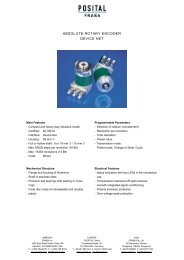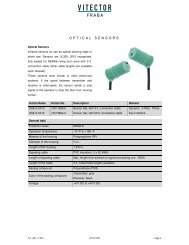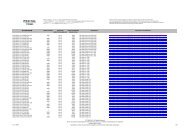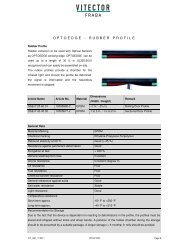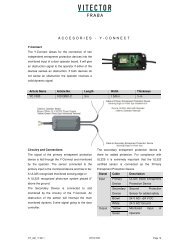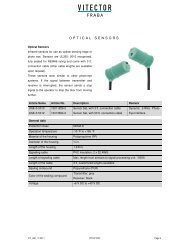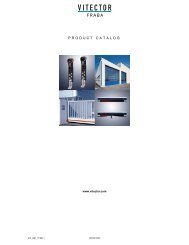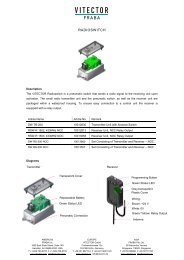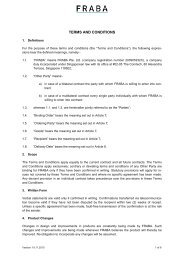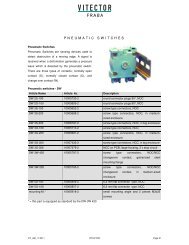OPTIPACT IN AUTOMATED GUIDED VEHICLES (AGV) (AN ...
OPTIPACT IN AUTOMATED GUIDED VEHICLES (AGV) (AN ...
OPTIPACT IN AUTOMATED GUIDED VEHICLES (AGV) (AN ...
You also want an ePaper? Increase the reach of your titles
YUMPU automatically turns print PDFs into web optimized ePapers that Google loves.
AMERICAS<br />
FRABA Inc.<br />
1800 East State Street, Suite 148<br />
Hamilton, NJ 08609-2020, USA<br />
T +1 609 750-8705, F +1 609 750-8703<br />
www.intacton.com info@intacton.com<br />
<strong>OPTIPACT</strong> <strong>IN</strong> <strong>AUTOMATED</strong> <strong>GUIDED</strong> <strong>VEHICLES</strong> (<strong>AGV</strong>)<br />
(<strong>AN</strong> APPLICATION NOTE)<br />
www.intacton.sg<br />
EUROPE<br />
<strong>IN</strong>TACTON GmbH<br />
Carlswerkstrasse 13c<br />
D-51063 Köln, GERM<strong>AN</strong>Y<br />
T +49 221 96213-0, F +49 221 96213-80<br />
www.intacton.de info@intacton.de<br />
ASIA<br />
FRABA Pte. Ltd.<br />
60 Alexandra Terrace,<br />
#02-05 The Comtech, S<strong>IN</strong>GAPORE 118502<br />
T +65 6514 8880, F +65 6271 1792<br />
www.intacton.sg info@intacton.sg
Synopsis<br />
The application note describes why <strong>OPTIPACT</strong> is<br />
an ideal solution and an enhancement to <strong>AGV</strong><br />
measurement applications. At the outset, OPT is<br />
compact in design and easily mountable through a<br />
straightforward installation. It does not require any<br />
additional components hence comparatively<br />
cheaper than the current technologies in place. OPT<br />
uses non-contact measurement principle and attains<br />
output of good resolution (up to 10µm) and very<br />
high accuracies (measurement uncertainty < 1%).<br />
The whole sensor is highly protected from external<br />
contaminants with a high protection class of IP65.<br />
The Automated Guided Vehicle (<strong>AGV</strong>) is a material<br />
handling robot, ideally used for shifting of materials<br />
within an industry but without any manual support or<br />
intervention. The main scope of <strong>OPTIPACT</strong> (OPT)<br />
in <strong>AGV</strong> applications is for the precise measurement<br />
of velocity and distance traversed. Automated<br />
Guided Vehicles (<strong>AGV</strong>s) are widely used in<br />
industries such as Automotive, Manufacturing,<br />
Distribution centers and Pharmaceuticals to move<br />
material around. OPT in <strong>AGV</strong>s can measure both<br />
the distance travelled, the velocity and can also<br />
raise alarms in case of inappropriate movement.<br />
The OPT also has an added advantage of<br />
measuring under dynamic conditions-such as<br />
deviation of working distance and also 2D<br />
directional measurement.<br />
<strong>OPTIPACT</strong> TECHNOLOGY IMAGE CORRELATION<br />
Page 2<br />
(Consecutive images are compared and the difference in position of the<br />
distinct markings corresponds to the 2D movement.)<br />
To summarize in one line, OPT is a compact,<br />
cheap, flexible and an accurate measurement<br />
system with good ingress protection and capable of<br />
measuring over dynamic conditions with utmost<br />
precision.<br />
Technology<br />
The <strong>AGV</strong>s use wired tracks, magnetic guide tapes,<br />
laser guides or rotary encoders coupled with the<br />
wheel shafts and measurement wheels to navigate<br />
the <strong>AGV</strong>. Although these systems work well they<br />
have their own disadvantages. For example, RF<br />
transmitting wires embedded into the surface of<br />
movement are expensive and an immutable<br />
solution. Even if the tape guides present a low cost<br />
solution, the main disadvantages of these systems<br />
are that multiple or cross tracks cannot be easily<br />
traced by the <strong>AGV</strong>.<br />
Mechanical measurement solutions like the rotary<br />
encoders or measurement wheels generally have a<br />
mechanical slippage during measurement and this<br />
considerably reduces the accuracy. The non-contact<br />
laser target navigation mechanism which is<br />
extensively used nowadays is accurate but a costly<br />
method of measurement since it requires suitable<br />
transmitters and receivers.
The OPT uses a very simple non-contact, slippage<br />
free measurement principle. It is basically a simple<br />
correlation method whereby the surface is observed<br />
by a camera suitably illuminated by appropriate light<br />
sources. Displacement, direction and velocity are<br />
analyzed and calculated by comparing consecutive<br />
high resolution surface pictures. Image correlation<br />
relies on image overlaps within a captured<br />
sequence of images. The OPT has different models<br />
varying in the range of measurement velocity,<br />
illumination (LED, Laser) and the optics used for<br />
focus, making it suitable for flexible measurements<br />
over a wide range of measurement surfaces and<br />
velocities.<br />
OPT in Automated Guided Vehicles (<strong>AGV</strong>)<br />
WHY USE <strong>OPTIPACT</strong> <strong>IN</strong> <strong>AGV</strong>’s?<br />
The <strong>OPTIPACT</strong> is attached as an external input<br />
device to <strong>AGV</strong>, so as to provide input signals,<br />
enabling safe and automated material movement.<br />
Ultimately, it helps in accurate path guidance<br />
configuration.<br />
Mounting<br />
Since, the OPT does not require any additional<br />
accessories for measurement, the installation of<br />
OPT is very easy and straightforward. There is a<br />
particular working distance with a flexible deviation<br />
Page 3<br />
of up to 20% which has to be maintained for<br />
accurate measurement.<br />
The <strong>AGV</strong> application is a mobile application and<br />
requires the related measurement to be done<br />
dynamically too. This flexibility in measurement<br />
conditions is an advantage for measurement over<br />
uneven surfaces. The OPT too is a very flexible and<br />
ideal for dynamic measurement. Generally, in <strong>AGV</strong>s<br />
the <strong>OPTIPACT</strong> is mounted under the chassis as<br />
shown in the picture above. The <strong>OPTIPACT</strong> can be<br />
mounted virtually anywhere as it has its own<br />
illumination and it is also not easily affected by<br />
external contaminants because of high Ingress<br />
protection (of up to IP65).<br />
• Non-Contact Principle<br />
The optical non-contact principle of measurement<br />
in OPT is very simple and convenient to use on<br />
<strong>AGV</strong>s. It does not require any additional<br />
accessories, can measure over any surface and has<br />
its own illumination making it a less expensive,<br />
flexible and convenient solution. But, the most<br />
important aspect is that there is no slippage in<br />
measurements as in measurements with encoders<br />
coupled to the shaft or using measurement wheels.<br />
Good resolutions of up to 10µm and errors < 1% are<br />
achievable in 2 dimensions as shown above.
• Velocity Switch (Digital Output)<br />
The <strong>OPTIPACT</strong> has a unique feature of being able<br />
to produce alarm outputs if the measurement<br />
parameter exceeds a particular value. Mostly, <strong>AGV</strong><br />
manufacturers use this alarm or digital output<br />
feature as a safety to indicate if the <strong>AGV</strong> has<br />
exceeded a particular velocity/acceleration.<br />
<strong>OPTIPACT</strong> can be programmed to raise alarms if it<br />
deviates from a particular surface too using the<br />
above provisions.<br />
• Navigation Guidance<br />
There are basically two different navigations for<br />
<strong>AGV</strong>s -fixed path and free ranging navigation.<br />
� Fixed Path: Involves pre-defined start, stop<br />
and navigation points. <strong>OPTIPACT</strong>’s accurate<br />
incremental signals interfaced with the control<br />
systems provide the least uncertainty in fixed<br />
path navigation.<br />
� Free-ranging navigation: Requires velocity<br />
measurement, distance calculation and<br />
additional safety features, all provided by OPT<br />
as a single entity.<br />
• Flexibility<br />
The <strong>AGV</strong> is a mobile application and therefore the<br />
measurement environment is constantly varying.<br />
The sensor used for such measurements and<br />
feedback should be capable of producing an<br />
accurate output even under dynamic conditions.<br />
Page 4<br />
Usually, there is a shift in centre of gravity of <strong>AGV</strong>s<br />
carrying heavy loads when negotiating bends. This<br />
coupled with imperfect traction between the wheels<br />
and floor can cause slippages. OPT is a non-contact<br />
and flexible measurement system having a wide<br />
range of working distance and the deviations due to<br />
loading will not affect the measurements. Also, as<br />
opposed to the 1D measurement of rotary encoders,<br />
the <strong>OPTIPACT</strong> sensors allow measurements of<br />
position and velocity, in 2D and are useful in<br />
detecting and correcting any deviations of the <strong>AGV</strong>s<br />
from its planned path. The flexibility in navigation<br />
and the capability of measuring in the dynamic<br />
environment make <strong>OPTIPACT</strong> the ideal solution for<br />
<strong>AGV</strong> applications.<br />
• Measurement Surfaces<br />
Unlike wired sensors and guide tape sensors,<br />
<strong>OPTIPACT</strong>s do not need any special surfaces to<br />
work on. <strong>OPTIPACT</strong>s were mainly tested on sealed<br />
concrete floor as well as black/yellow striped tape<br />
floor, two types of floor surfaces that would typically<br />
be encountered in an industrial environment, and<br />
found to be performing well with a high level of<br />
accuracy (i.e. measurement error lesser than 1% of<br />
distance measured). Further simple tests show that<br />
<strong>OPTIPACT</strong> performed well over shiny surfaces,<br />
rough punch carpets, colored tapes and all such<br />
surfaces.
APPENDIX A: <strong>AGV</strong> APPLICATION SIMULATOR<br />
• Measurement over Different Surfaces using OPT-L<br />
Page 5<br />
The <strong>AGV</strong> simulator is simple setup where the OPT is<br />
mounted on a movable platform on wheels just as in the<br />
<strong>AGV</strong> (under the chassis). Simple measurement tests<br />
were conducted to test the measurement statistics, the<br />
flexibility of measurements etc.<br />
Shiny White Surface Coloured Strips Rough Punch<br />
+ve Error 0.64% +ve Error 0.83% +ve Error Carpets 0.75%<br />
Max:<br />
Max:<br />
Max:<br />
-ve Error -0.84% -ve Error -0.69% -ve Error -0.67%<br />
Max:<br />
Max:<br />
Max:<br />
Absolute 0.12% Absolute 0.2% Absolute 0.4%<br />
Meas Err:<br />
Meas Err:<br />
Meas Err:<br />
The error is less than 1% in all the measurements over various surfaces of<br />
measurements.<br />
• Measurement over deviation in working distance using OPT-L<br />
Working<br />
Dist<br />
Deviation<br />
-ve Error Max: -0.9 %<br />
+ve Error Max: 0.71%<br />
Absolute Measurement Error: 0.23%<br />
The contour of the deviation and the smart adaptation of the OPT (adjusts shutter value to maintain the image<br />
quality) are shown above. Even with deviation of working distance the Image quality is kept constant providing<br />
accurate measurement.<br />
OPT Measurement with Deviation<br />
Error Calculation: If X is the actual length and X’ is the measured length. (X - X’) = ±∆X<br />
+ve Error<br />
Max=[(∆X)/X)]%<br />
Length Traversed<br />
Simulated<br />
deviation of<br />
±15mm<br />
-ve Error Max=<br />
[(-∆X)/X)]%<br />
Const<br />
Image<br />
Quality<br />
Change of<br />
Shutter<br />
value to<br />
optimize IQ<br />
Absolute Meas Error=<br />
Σ[(±∆X)/X)]%
APPENDIX B: SELECTION OF APPROPRIATE <strong>OPTIPACT</strong> MODEL<br />
Step 1: Identify maximum possible working distance<br />
The OPT-L has the largest working distance<br />
variation of 30 mm ± 6 mm (1.18 in ± 0.3 in), the<br />
OPT-S has a working distance of 40 mm ± 4 mm<br />
(1.57 in ± 0.15 in) and OPT-F has the minimum,<br />
15.5 mm ± 1.5 mm (0.61 in ± 0.06 in). The<br />
differences are due to the different optics,<br />
illumination and lenses used.<br />
Step 2: Identify the measurement surface<br />
The surfaces that can be measured, range from the<br />
smoothest of surfaces like rubber, plastic, molded<br />
floors to the coarsest like punch carpets, graveled<br />
path etc. Hence the correct OPT needs to be used<br />
according to the surface to be measured upon.<br />
The OPT-S is an average measurement system<br />
capable of measuring over surfaces with good<br />
optical structures caused roughness and varying<br />
reflectivity.<br />
The increased optical resolution of OPT-F enables<br />
applications on materials (such as regular<br />
photocopying paper) with very fine surface<br />
structures, imperceptible at first glance to the<br />
human eye.<br />
The OPT-L has an internal laser illumination instead<br />
of a visible LED illumination, hence, measures on<br />
very smooth surfaces with structures imperceptible<br />
to the human eye. This is particularly true for<br />
reflective or glossy materials too. Motion can also<br />
be well detected on materials that appear to have a<br />
homogeneous structure.<br />
Page 6<br />
Step 3: Identify working conditions and tentative<br />
ranges of measurement<br />
The OPT-S is the typical mid range sensor with<br />
velocity range up to ± 4 m/s (13 ft/s) and the OPT-F<br />
corresponds to a smaller velocity range of ± 1 m/s<br />
(180 ft/min), but the new OPT-L can measure<br />
speeds up to ±4m/s (800ft/min).<br />
P.S: The OPT-M is not suitable for <strong>AGV</strong><br />
applications due to its larger size and suitability<br />
in specific industrial applications only.<br />
________________________________________<br />
Release Notes<br />
Version Date : May 13 th , 2011<br />
Author : Nachiappa Anjan (<strong>AN</strong>A)<br />
Document Name: OPT_ApplicationNote_<strong>AGV</strong>.pdf<br />
Reviewed By : CWA, ILA, CDS<br />
For more detailed information:<br />
<strong>OPTIPACT</strong><br />
Other Applications



